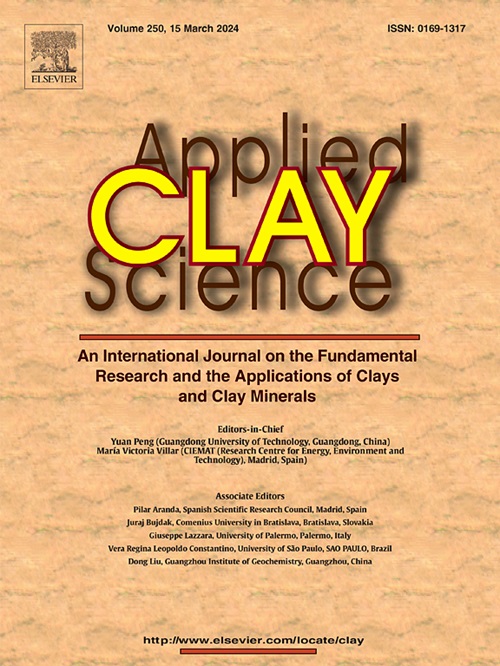Ternary hybrid nanocomposites based on polypyrrole/manganese dioxide/palygorskite clay for electrochemical supercapacitor applications
IF 5.8
2区 地球科学
Q2 CHEMISTRY, PHYSICAL
引用次数: 0
Abstract
Ternary nanocomposites containing polypyrrole (PPy), manganese dioxide (MnO2), and two distinct acid-treated palygorskite (Pal) clays were prepared by in situ chemical oxidative polymerization for electrochemical supercapacitor applications. The resulting composites were fully characterized in terms of structure, morphology, and electrochemical properties. MnO2 nanorods were hydrothermal synthesized, while natural Pal clay was modified by two sequential acid treatments not only for clay purification but also to increase its specific surface area and porosity. The Pal clay was initially treated with a 1 M HCl solution, designated as Pal1, and subsequently treated with a 5 M H2SO4 solution to yield Pal2. Pal clay was incorporated in order to increase the dimensional stability during the doping-dedoping process. Two ternary nanocomposites, designated as PMP1 and PMP2 were formed through in-situ polymerization of pyrrole on Pal1/MnO2 or Pal2/MnO2 mixtures, respectively. The ternary electrodes exhibited a notable enhancement in the cycle life of the supercapacitors due to the incorporation of acid-treated clays, retaining up to 98 % of their initial capacitance after 1600 charge-discharge cycles. In contrast, the device containing PPy/MnO2 electrodes (PM) retained only 78 % of its initial capacitance. Furthermore, the highest specific capacitance of 205 mF cm−2 at 3 mA cm−2 was obtained for the PMP1 supercapacitor by the GCD method, which delivered a maximum energy density of 13 mW h cm−2 with a power density of 335 mW cm−2. These results demonstrate for the first time the potential application of acid-treated Pal clays in improving cycle stability of the PPy/MnO2 electrode materials. This approach could also be adapted for other types of binary electrode materials.
聚吡咯/二氧化锰/坡缕石粘土三元杂化纳米复合材料在电化学超级电容器中的应用
采用原位化学氧化聚合法制备了聚吡啶(PPy)、二氧化锰(MnO2)和两种不同酸处理的坡高岭土(Pal)粘土三元纳米复合材料,用于电化学超级电容器。所得到的复合材料在结构、形貌和电化学性能方面得到了充分的表征。采用水热法合成二氧化锰纳米棒,通过连续两次酸处理对天然Pal粘土进行改性,不仅可以净化粘土,还可以提高其比表面积和孔隙率。Pal粘土最初用1m的HCl溶液处理,称为Pal1,随后用5m的H2SO4溶液处理,得到Pal2。为了提高掺杂-脱掺杂过程的尺寸稳定性,加入了Pal粘土。通过吡咯在Pal1/MnO2或Pal2/MnO2混合物上原位聚合,制备了两种三元纳米复合材料PMP1和PMP2。由于酸处理粘土的掺入,三元电极在超级电容器的循环寿命中表现出显著的增强,在1600次充放电循环后保持了98%的初始电容。相比之下,含有PPy/MnO2电极(PM)的器件仅保留了其初始电容的78%。此外,通过GCD方法获得了PMP1超级电容器在3ma cm−2下的最高比电容为205 mF cm−2,其最大能量密度为13 mW h cm−2,功率密度为335 mW cm−2。这些结果首次证明了酸处理Pal粘土在改善PPy/MnO2电极材料循环稳定性方面的潜在应用。这种方法也适用于其他类型的二元电极材料。
本文章由计算机程序翻译,如有差异,请以英文原文为准。
求助全文
约1分钟内获得全文
求助全文
来源期刊

Applied Clay Science
地学-矿物学
CiteScore
10.30
自引率
10.70%
发文量
289
审稿时长
39 days
期刊介绍:
Applied Clay Science aims to be an international journal attracting high quality scientific papers on clays and clay minerals, including research papers, reviews, and technical notes. The journal covers typical subjects of Fundamental and Applied Clay Science such as:
• Synthesis and purification
• Structural, crystallographic and mineralogical properties of clays and clay minerals
• Thermal properties of clays and clay minerals
• Physico-chemical properties including i) surface and interface properties; ii) thermodynamic properties; iii) mechanical properties
• Interaction with water, with polar and apolar molecules
• Colloidal properties and rheology
• Adsorption, Intercalation, Ionic exchange
• Genesis and deposits of clay minerals
• Geology and geochemistry of clays
• Modification of clays and clay minerals properties by thermal and physical treatments
• Modification by chemical treatments with organic and inorganic molecules(organoclays, pillared clays)
• Modification by biological microorganisms. etc...
 求助内容:
求助内容: 应助结果提醒方式:
应助结果提醒方式:


